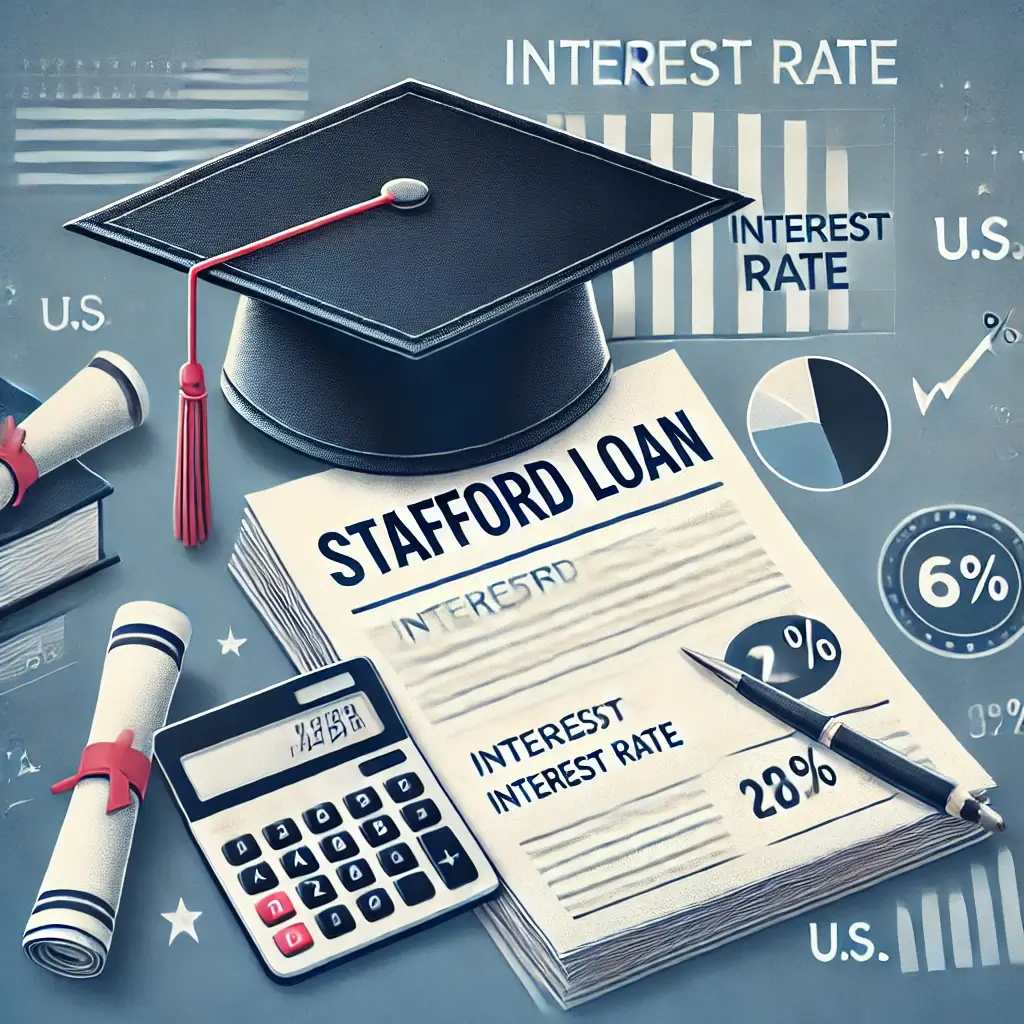For students looking to fund their education, Stafford Loans for Students offers accessible and flexible options. As part of the Federal Direct Loan Program, these loans come with low, fixed interest rates and a variety of repayment plans. In this guide, we’ll cover everything you need to know about Stafford Loans for Students, including eligibility requirements, benefits, and application steps.
1. What Are Stafford Loans?
Stafford Loans are federally funded student loans available through the U.S. Department of Education. They are designed to help students pay for tuition, books, and other educational expenses. There are two main types of Stafford Loans for Students: Subsidized Stafford Loans and Unsubsidized Stafford Loans.
1.1 Direct Subsidized Stafford Loans
- Eligibility: Available to undergraduate students with demonstrated financial need.
- Interest Benefits: The government pays the interest while the student is in school at least half-time, during grace periods, and throughout deferment.
- Loan Limits: Range from $3,500 to $5,500 annually, depending on your year in school.
Direct Subsidized Stafford Loans are ideal for students who qualify for need-based aid, as they help reduce the amount of interest paid over time, making them the best option for Stafford Loans for Students on a budget.
1.2 Direct Unsubsidized Stafford Loans
- Eligibility: Available to undergraduate, graduate, and professional students without the need to demonstrate financial need.
- Interest: Interest accrues from the time the loan is disbursed, and the borrower is responsible for paying it.
- Loan Limits: Range from $5,500 to $20,500 annually, based on your academic level and dependency status.
For students who do not qualify for need-based aid or need additional funds, Unsubsidized Stafford Loans are a top choice in the Stafford Loans for Students program.
2. Key Benefits of Stafford Loans for Students
Stafford Loans offer several advantages that make them a popular choice among federal student loan options. Here’s why Stafford Loans for Students stand out:
2.1 Lower, Fixed Interest Rates
The Interest Rates on Stafford Loans are lower and fixed for the life of the loan, which makes planning and budgeting easier. Fixed rates ensure that your monthly payments remain the same over time, providing stability.
2.2 Flexible Repayment Options
With Stafford Loans for Students, you have access to a range of repayment plans, including:
- Standard Repayment Plan: Fixed monthly payments over 10 years.
- Graduated Repayment Plan: Payments start low and increase every two years.
- Income-Driven Repayment Plans: Monthly payments are based on your income and family size.
These options allow borrowers to select a plan that fits their budget and financial goals, making Stafford Loans for Students a highly adaptable solution.
2.3 Deferment and Forbearance Options
If you experience financial hardship, Stafford Loans offer the flexibility of deferment or forbearance. This means you can temporarily postpone payments if you’re facing challenges such as job loss or returning to school.
2.4 Loan Forgiveness Eligibility
Stafford Loans can be eligible for various loan forgiveness programs, such as Public Service Loan Forgiveness (PSLF) for students entering qualifying fields. This benefit makes Stafford Loans for Students an attractive option for those planning a career in public service.
3. How to Apply for Stafford Loans for Students
Applying for Stafford Loans for Students is straightforward. Here’s a step-by-step guide:
3.1 Complete the FAFSA
To be eligible for Stafford Loans, you must complete the Free Application for Federal Student Aid (FAFSA). This form is available online and should be submitted annually to determine your eligibility for federal student aid, including Stafford Loans.
3.2 Review Your Financial Aid Offer
Once your FAFSA is processed, your school’s financial aid office will send you an aid offer, which includes details on the types and amounts of federal loans you qualify for. Evaluate this carefully to decide how much you need in Stafford Loans for Students.
3.3 Accept Your Loan Offer
After reviewing your aid offer, accept the loan amount you need. You’re not required to accept the full amount, and it’s generally wise to borrow only what you need to cover essential expenses.
3.4 Complete Entrance Counseling and Master Promissory Note (MPN)
First-time borrowers must complete entrance counseling, which ensures they understand their loan obligations. You’ll also need to sign a Master Promissory Note (MPN) agreeing to the terms of your Stafford Loan.
4. Interest Rates for Stafford Loans
The Interest Rates for Stafford Loans are set annually by Congress. These rates are fixed for the life of the loan, providing predictability for borrowers. As of the most recent academic year:
- Subsidized Stafford Loan Rate: 5.05% for undergraduates.
- Unsubsidized Stafford Loan Rate: 5.05% for undergraduates, 6.6% for graduate students.
Understanding these rates helps you make informed decisions about how Stafford Loans for Students fit into your overall financial plan.

5. Loan Limits for Stafford Loans
Stafford Loans have annual and aggregate borrowing limits that vary based on your academic year and dependency status. Here’s a table of Stafford Loans for Students borrowing limits:
| Academic Year | Dependent Students | Independent Students |
|---|---|---|
| Freshman | Up to $5,500 | Up to $9,500 |
| Sophomore | Up to $6,500 | Up to $10,500 |
| Junior & Senior | Up to $7,500 | Up to $12,500 |
| Graduate Students | Not applicable | Up to $20,500 |
These limits ensure that students don’t over-borrow while providing enough funds to cover essential education-related expenses. Stafford Loans for Students offer a balanced approach to borrowing, ideal for those pursuing undergraduate and graduate degrees.
6. Stafford Loans and Repayment Options
Repayment for Stafford Loans begins after a six-month grace period following graduation, leaving school, or dropping below half-time enrollment. Borrowers can choose from several repayment options tailored to fit their financial circumstances:
6.1 Standard Repayment Plan
Fixed payments over 10 years. This plan saves the most on interest costs, making it a good option for those who can afford steady payments.
6.2 Graduated Repayment Plan
Payments start low and increase every two years, perfect for those who expect their income to rise over time.
6.3 Income-Driven Repayment Plans
Monthly payments are based on a percentage of discretionary income, which can significantly reduce the burden of repayment. Available plans include:
- Income-Based Repayment (IBR)
- Pay As You Earn (PAYE)
- Revised Pay As You Earn (REPAYE)
These flexible options make Stafford Loans for Students accessible and manageable for borrowers with various financial needs.
7. Frequently Asked Questions about Stafford Loans for Students
7.1 Do I Need a Credit Check for Stafford Loans?
No, Stafford Loans do not require a credit check. This makes them accessible for students who may not have an established credit history.
7.2 Can I Refinance My Stafford Loans?
Federal loans, including Stafford Loans, cannot be refinanced within the federal system. However, you can refinance through a private lender, although this means losing federal benefits.
7.3 Are Stafford Loans Eligible for Loan Forgiveness?
Yes, Stafford Loans are eligible for forgiveness programs like PSLF, which offers loan forgiveness for borrowers in qualifying public service positions after making 120 qualifying payments.
Conclusion
Stafford Loans provide accessible, affordable financing options for students pursuing higher education. With low, fixed interest rates, flexible repayment plans, and eligibility for loan forgiveness, Stafford Loans for Students is one of the best choices for funding college and beyond. By understanding the types, benefits, and application process, you can make an informed decision about using Stafford Loans to achieve your educational goals without undue financial stress.
